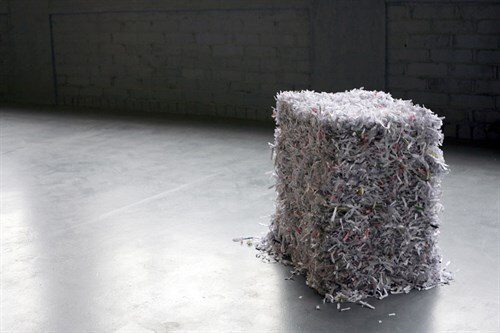Jeannie Driver: Artist of the Month March 2012

Artist Jeannie Driver discusses cathartic activities, working with others and the importance of making things better.
How do you start making work?
Jeannie Driver: I always choose an issue or theme as a starting point for work, one that we all have a pre-existing relationship with. It's important to start from a shared perspective. Currently I am working with paper, gathered from offices and my own personal archive of ‘waste’ generated from many years of project management and arts administration.
What interested you about paper?
JD: The focus on paper started with my personal relationship with it. Paper seemed to materialise with a vengeance. I'm not a natural writer, words are not my first language and I would sweat over and over writing funding applications and proposals. Paper is a symbol of the unavoidable web of bureaucracy. I built a 6ft spike first, just to 'spike' the paper, which was very satisfying!
Later, the work developed into a project to take into offices called 'SPIKE IT', (2007). I worked with office workers and the project resulted in lots of discussions about a love of the physicality of the document on the page, and the value attached to the tangible object as opposed its digital form.

You also shred paper...
JD: Yes. The act of shredding is cathartic, the destruction, the change of form creates a new purpose for the material whilst retaining snippets of its former value. When documents are shredded, the content and value of the paper changes, the linear presence of the text is destroyed and the focus is brought back to the material as a resource and commodity. Repetition, time, production and reproduction as themes for contemporary life are explored through the use of this material; a material that seems to effervesce from all corners of life.
Getting people involved with projects seems central to your practice.
JD: Yes, I was inspired at university by Suzanne Lacy and the quote by Estella Conwill Majazo on the cover of Mapping the Terrain, New Genre Public Art, (1995): 'To search for the good and make it matter. This is the real challenge for the artist. Not simply to transform ideas or revelations into matter, but to make those revelations actually matter'. This became my mantra, and forged my interest in audience, and the relationship between artist and audience. It led to many years of relational projects and public art projects, creative championing, mentoring and generally trying to find a relevance and role for the arts.
I have always worked to a strategy to involve people during the research or production stage of making work, either as the work, as contributors, or participants, or more recently as volunteers in dialogue and making. This can be through interviewing people on their relationship with paper, or receiving unsolicited contributions of bags of shredded paper to use in my work. Recently I undertook a 'Shy Shredding' event as part of the Brighton Light Night, where visitors shredded documents, messages, pages from diaries and even money to add them to an installation of a mountain of shredded paper. This was a really popular activity and the people seemed to find the act of shredding cathartic.

What advice you would you give an artist?
JD: You should have tenacity, drive, commitment, and make art for the love and need of it. I believe there are many approaches and genres that make up the ‘art pie’, all are necessary and feed each other. Consider where you place yourself and where you are going. I believe you should see art as an equation between you the artist, the audience (in its widest sense) and the location/context. Finally, be true to yourself rather than try and make a pastiche of something else that has gained some 'success'.
If you could change one thing, what would it be?
JD: It would be the ability to be in the studio every day and to have assistants. My ideas are always bigger than myself! And to be represented by a gallery so I don’t have to worry about money. I would also bring back exhibition payment rights, and ensure that galleries pay artists. I have loads more but my soap box is getting pretty battered...
What’s next?
JD: After many years of producing relational works, I’m enjoying the freedom of the gallery space, developing some new works for open shows and sculptural installations for large gallery spaces. These are being developed as drawings and smaller works that can be upscaled. I may be being a little too ambitious but it’s the spaces that inspire the possibilities!
Artists
Tags, Topics, Artforms, Themes and Contexts, Formats
Share this article
Helping Artists Keep Going
Axis is an artist-led charity supporting contemporary visual artists with resources, connection, and visibility.


